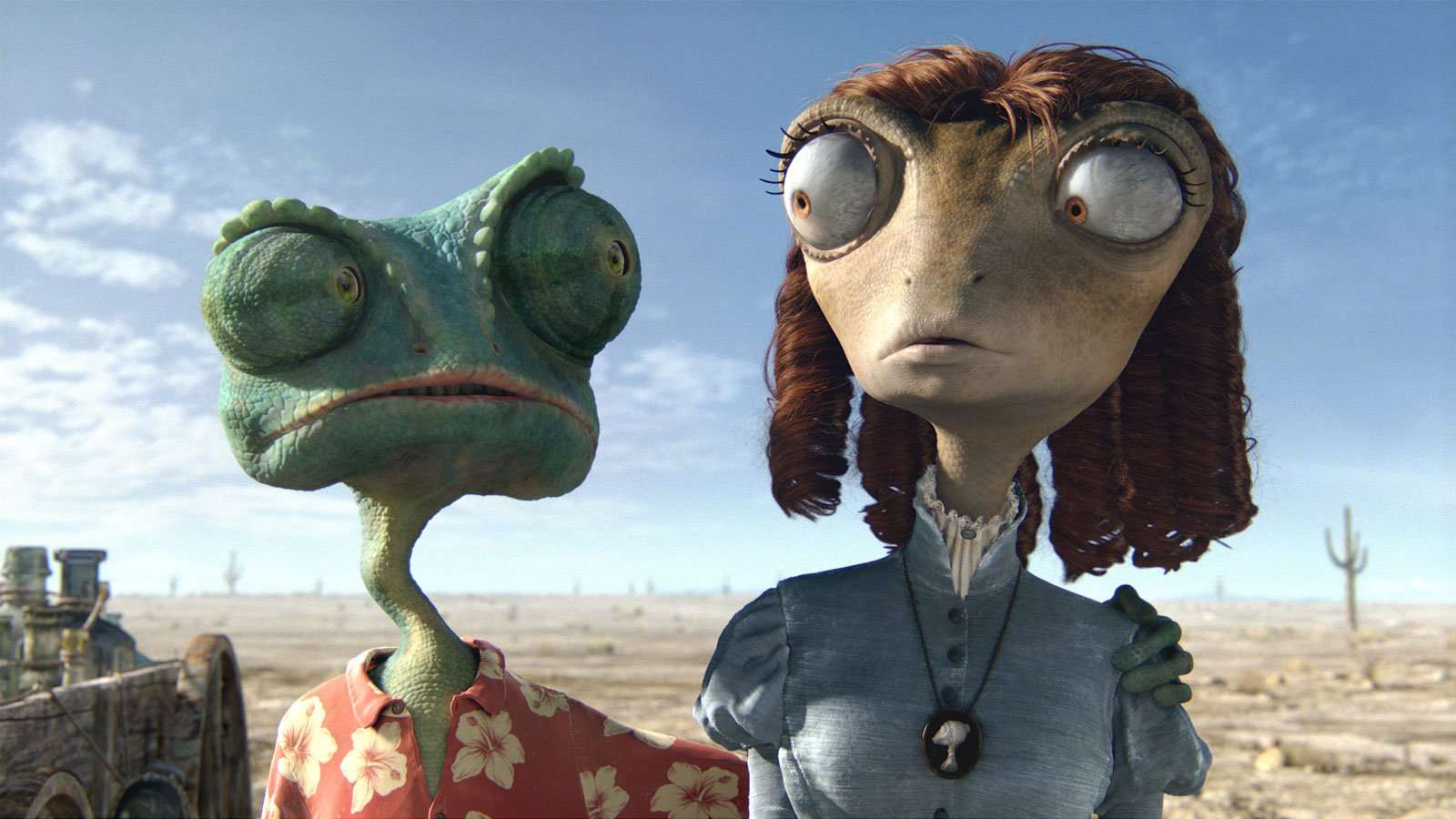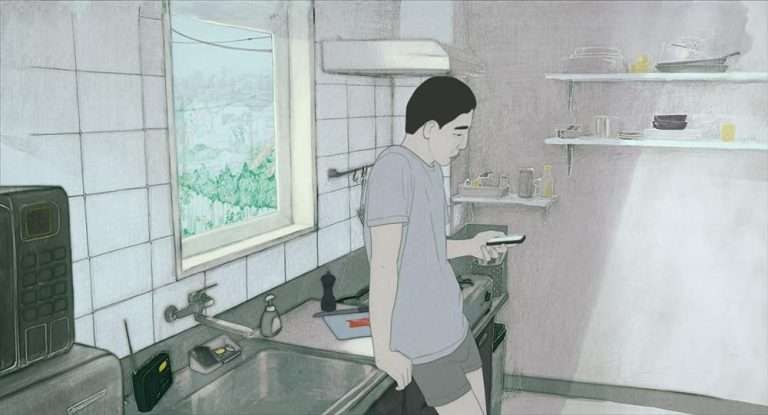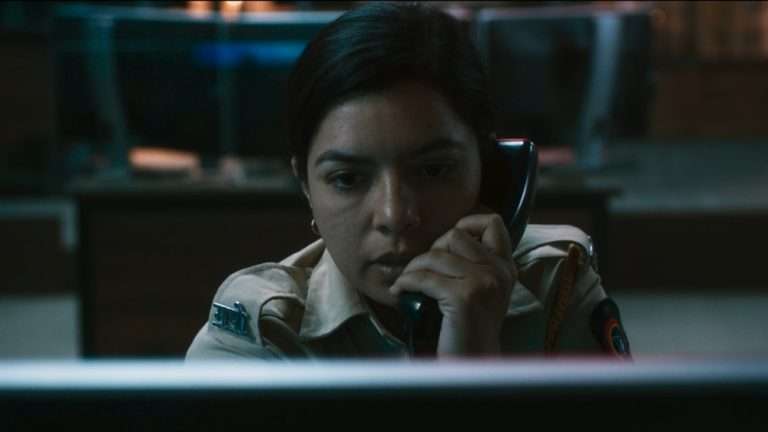“Rango” is one of those movies that inevitably leaves you a little disappointed, but not because of the movie itself. Whatever problems you might have with the charming little film, it’s still a fantastic achievement in 3D animation that has gone criminally overlooked in the twelve-odd years since its theatrical release. Revisiting “Rango” in 2024, I was disappointed because I saw it as exactly the kind of film that Hollywood doesn’t make enough of.
The film follows a nameless chameleon with a passion for acting. When a road accident suddenly flings the tiny lizard from his safe but lonely tank and out into the baking glare of the Mojave sun, he’s forced to wander the desert in search of life-saving water. After arriving in Dirt, a dried-up little town on the verge of a critical water shortage, he adopts the persona of ‘Rango,’ a legendary gunslinger and killer of renown. After the townsfolk named him sheriff, Rango discovers clues as to what (or who) is causing the drought that’s gripping Dirt and its citizens.
Crucially, “Rango” dedicates just as much effort into being a good Western as it does to poking fun at the Western. It cranks the style of its world up to eleven and dazzles the viewer with sweeping landscapes, extreme closeups, and a constant visual momentum to all of the action. The shooting style is reminiscent of the titanic vision of the iconic Spaghetti Westerns, which reimagined The Old West into a place of myth rather than reality. The plot itself may be fairly safe, but Rango’s quest for identity has enough meat on the bone to support an odyssey through a world unlike any rendered on screen before.
The animation opens up the action to a greater scope than the Western genre is typically used to. Director Gore Verbinski, who already proved his mastery at large-scale action set pieces in his uber-successful “Pirates of the Caribbean” trilogy, gets to go wild in “Rango” with the freedom of cyberspace. Scenes of The Hawk chasing Rango through Dirt, or the excellent ‘Valkyrie’ Bat chase sequence feel as huge and weighty as they are outlandish and fun, and all of it ‘shot’ without the physical restrictions that plagued the creation of his live-action Pirates films.
Perhaps the film’s commitment to its own artful sense of ugliness prevented it from reaching Pixar/Dreamworks levels of renown, but the look of “Rango” gives the film its soul. The run-down desert village setting practically comes alive. Every part of this miniature Wild West is constructed out of salvaged bric-a-brac (much like the endlessly creative dumpster-dive design work behind “Mad Max Fury Road” (2014)), but it’s the character designs that steal the show.
Every animal citizen of Dirt is rich in squalid, dusty detail. They are cartoonish and visually expressive yet still evoke the Wild West archetypes that inspire them, always staying true to the genre homage at the film’s core. You won’t find any cute ‘Pixar eyes’ in “Rango” and nothing as cuddly looking as a Minion. Even Rango and his love interest, Beans, are kind of off-putting to look at, yet it works spectacularly in favor of the movie’s art direction. The visual language of “Rango” is one of a kind, freed from the quagmire of sticking to something ‘safe’ or ‘cute’ for the marketable pleasure of its young audience.

All of the film’s gangly, scaly lumpiness isn’t there just for novelty. “Rango” takes many of its action/adventure cues from classic Looney Tunes and Tex Avery animations, and the commitment to the pleasantly unpleasant look of Dirt and its critter citizens complements the visual comedy effortlessly. The style, the texture, the slapstick—it all combines into an expressive vision that feels like a high-tech continuation of the adventures of Wile E. Coyote and his eternal nemesis, Road Runner.
Performance-wise, the film is head and shoulders above most animated efforts. For all of his clumsiness, the titular lizard remains charming and lovable throughout. It’s clear that Depp is having just as much of a blast playing the character as he would with a live-action role. Similarly, the townsfolk of Dirt are played by the rogue gallery of incredible character actors, and there isn’t a dud performance among them. The film doesn’t lack strong antagonists, either. Ned Beatty devours the role of Tortoise John, taking some deliberate cues from Chinatown’s Noah Cross, while Bill Nighy, playing fan-favorite Rattlesnake Jake, lends his trademark talent for villainous roles, allowing the gargantuan serpent to practically ooze menace. Even minor antagonists like the thuggish Bill (Ray Winstone) and the ornery Balthazar (Harry Dean Stanton) are played with such visceral joy and inspiration that it’s hard not to wish they had more screen time.
This was no happy accident either. Verbinski purposefully chose to record the dialogue with actors performing together on set. This was no Krusty the Clown in the Soundbooth paycheck job. Watch behind-the-scenes footage, and you’ll find Depp, Fisher, Nighy, and Beatty all hamming it up in the same room together, chewing the scenery and getting to grips with the creatures they’ve been cast to play. In interviews, Verbinski even boasts that he pushed the animators to base the character’s movements on physical performances, capturing the all-important details that separate a competent performance from a great one. It’s not how things are usually done in Hollywood, but the more you look into Rango’s construction, the more you realize that almost none of it was done the ‘normal’ way.
Though the film performed well, it doesn’t enjoy the same level of nostalgia as Pixar Golden Age features, it didn’t shatter global markets like “Despicable Me,” nor is it likely to be unearthed by the ever-hungry meme machine like “Bee Movie” or the “Shrek” series. One can only speculate why the film sits in its own bubble in Hollywood history. Part of it is certainly down to the film’s singularly unfamiliar aesthetic. You can also highlight the off-color humor as a factor. It could also be argued that while the blending of a children’s film and a homage to the legacy of the Western genre works in favor of the film’s quality, it might not have translated into much enthusiasm from the intended audience of youngsters, many of whom might not have been as in love with Leone, Ford, and Peckinpah as the filmmakers themselves were.
Lamenting the dissonance between Rango and the modern animation industry, Verbinski had the following to say: “There are shackles with the budgets and the profit margins. You want to compete with what they’re doing at Pixar and DreamWorks. There’s a price tag with that just in terms of achieving that quality level. What happened to the Ralph Bakshis of the world? We’re all sitting here talking about family entertainment. Does animation have to be family entertainment? I think at that cost, yes.”
Despite the odds, “Rango” is ‘the little film that could.’ It’s More than enough fun for kids and adults alike, with plenty for fans of Westerns to enjoy, too. If you’re stuck for something to watch with the family, you really can’t go wrong with this one.



![The Girl With The Dragon Tattoo [2011]: Sultry Dragon on a Slender Shoulder](https://79468c92.delivery.rocketcdn.me/wp-content/uploads/2017/06/the-girl-with-the-dragon-tattoo-768x315.jpg)



